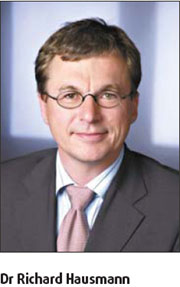Firms offer urbanization solutions
German companies are well positioned to offer state-of-the-art solutions for the challenges brought about by the urbanization process in China. As increasing urbanization is creating a need for advanced infrastructure and sophisticated urban planning, German industry is prepared to take part in China's efforts to improve the living standards of its urban population.
Partnerships and cooperation projects in the Chinese healthcare sector are believed to offer German companies a bright future. German-made medical engineering products enjoy a high reputation in China and make up 20 percent of Chinese imports in this sector.
In order to further facilitate Sino-German cooperation in the sector, a Memorandum of Understanding (MOU) was signed in September 2006 between the German Federal Ministry of Economics and Technology and China National Development and Reform Commission (NDRC), represented by German Federal Minister of Economics and Technology, Michael Glos, and Chairman of the NDRC Ma Kai. The MOU provides a basis for intensive cooperation between the two countries in the fields of healthcare and biotechnology, within the framework of the German-Chinese Forum for Economic and Technological Cooperation.
The Sino-German Friendship Hospital is certainly a showcase project in this area. A well-known internationally operating German company and a major German private hospital operator signed a MOU with Tongji University in Shanghai for joint funding and construction of the hospital during President Hu Jintao's state visit to Germany in November 2005.
The hospital will see a total investment of more than 1 billion yuan. With an overall floor space of 84,000 sq m and 500 beds, it will provide services in all major fields of healthcare. The first construction phase is scheduled for completion in 2009. It is envisaged that the hospital will commence operations before the World Expo in 2010.
German investment in China's healthcare sector is not limited to the construction of hospitals, but aims at manifold fields of expertise. German suppliers are ideally positioned to provide one-stop solutions for the current challenges China has to address. Cooperation and investment is promoted by the German-Sino Healthcare Group, which comprises leading Chinese and German companies.
Environmental protection
As world leaders in environmental engineering, German companies provide technology that contributes to responsible utilization of increasingly scarce resources, climate protection, and the reduction of harmful emissions.
Innovative German industrial equipment with high efficiency in the energy sector, or "smart" building technology that reduces energy requirements by up to 20 percent by using the latest control and instrumentation technologies and a further 50 percent through structural innovations, are further examples of German competency to support China's efforts to implement sustainable growth.
Furthermore, German industry has a strong presence in the recycling sector as well. In the fields of sewage and sludge treatment, foreign know-how and technologies are required to meet the objectives of managing high rates of leakage and increasing the rate of urban wastewater treatment from 45 to 70 percent in 2010.
German engagement covers a wide variety of functions, from consulting, planning and supply of facilities and components, to the complete construction and operation of plants.
German firms are considerably engaged in the modernization of the Chinese transportation system. Completed projects include metro lines in cities such as Beijing, Shanghai and Guangzhou, as well as high-speed lines connecting major Chinese cities.
In the foreseeable future, German industry will continue to focus on the development of Chinese megacities and provide approaches for their sustainable growth. During a three-year campaign starting later this year in Nanjing, German companies will present their know-how and reach out to Chinese partners for cooperation in this critical stage of China's development.
(China Daily 05/24/2007 page27)














